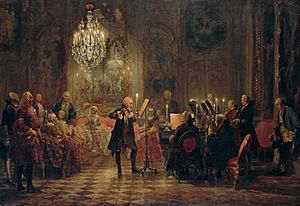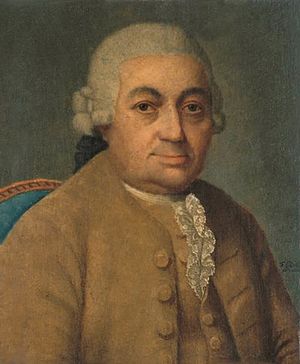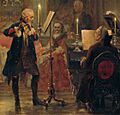Carl Philipp Emanuel Bach facts for kids
Carl Philipp Emanuel Bach (born March 8, 1714 – died December 14, 1788) was a famous German composer and musician. He was the fifth child of the even more famous composer Johann Sebastian Bach. People often called him C. P. E. Bach to make his name shorter.
C. P. E. Bach was a very important composer. He lived during a time when music was changing from the old Baroque style to the newer Classical style. His music was special because it was very expressive and often dramatic. This style was called empfindsamer Stil, which means 'sensitive style'. It was different from the lighter, more elegant "galant" style popular at the time.
To tell him apart from his brother, Johann Christian Bach, who lived in London, C. P. E. Bach was known as the "Berlin Bach" when he lived in Berlin. Later, he was called the "Hamburg Bach" when he took over from his godfather, Georg Philipp Telemann, as the music director in Hamburg. His middle name, Emanuel, was given in honor of Telemann, who was a good friend of his father.
Bach was also a great teacher. He wrote a very important book called "Essay on the True Art of Playing Keyboard Instruments". Many famous composers, like Haydn, Mozart, and Beethoven, studied this book.
Contents
Life of Carl Philipp Emanuel Bach
Early Years: 1714–1738
Carl Philipp Emanuel Bach was born on March 8, 1714, in Weimar, Germany. His father was Johann Sebastian Bach, and his mother was Maria Barbara. He was their fifth child. When he was ten, he went to the St. Thomas School, Leipzig, where his father worked as a music director.
Carl and three of his brothers became professional musicians. Their father taught them almost everything they knew about music. Even though he was a musician, Carl also studied law at the University of Leipzig and later in Frankfurt. He finished his law studies in 1738 but decided to focus on music instead.
Berlin Years: 1738–1768
After finishing his studies, Bach got a job in Berlin working for Crown Prince Frederick of Prussia. This prince later became Frederick the Great. In 1740, when Frederick became king, Bach joined the royal orchestra. He was one of the best keyboard players in Europe.

Berlin was a very artistic city. Bach met many talented musicians and writers there, like Gotthold Ephraim Lessing, who became a close friend. During this time, Bach wrote many pieces for solo keyboard, including a famous one called "La Caroline". He also published two sets of sonatas that made him well-known.
Bach was influenced by his father, Georg Philipp Telemann, and later by composers like George Frideric Handel, Joseph Haydn, and Wolfgang Amadeus Mozart. In turn, Bach's own music influenced Haydn, Mozart, and Beethoven.
While in Berlin, Bach wrote a setting of the Magnificat (a religious song), an Easter cantata, and many symphonies and concertos. He also wrote three books of songs, including the popular Gellert Songs. But most of his work was for the keyboard. He composed almost 200 sonatas and other solo pieces.
His most important work in Berlin was his book, Versuch über die wahre Art das Clavier zu spielen (An Essay on the True Art of Playing Keyboard Instruments). This book quickly became a guide for playing keyboard instruments. It taught how to use fingers, how to add musical decorations like trills, and how to play with expression. Haydn and Beethoven both loved this book.
Bach used keyboard instruments made by Gottfried Silbermann, a famous builder. Modern piano makers still use Silbermann's pianos as models today.
Hamburg Years: 1768–1788
In 1768, Bach moved to Hamburg to take over from his godfather, Georg Philipp Telemann, as the music director. This new job meant he had to write a lot of music for church services, especially for the Michaeliskirche.
In Hamburg, Bach started writing more church music. In 1769, he wrote his biggest work, the oratorio Die Israeliten in der Wüste (The Israelites in the Desert). An oratorio is a large musical piece for voices and orchestra, usually based on a religious story. Between 1768 and 1788, he wrote 21 settings of the Passion (the story of Jesus's suffering) and about 70 cantatas and other church pieces.
In 1773, Bach wrote his autobiography, which was one of the first times a composer wrote about their own life. He also performed works by other composers, including his father, Telemann, Haydn, and Mozart. His most important choral works were Heilig (Holy) and the oratorio Die Auferstehung und Himmelfahrt Jesu (The Resurrection and Ascension of Jesus). Mozart himself conducted performances of Auferstehung in Vienna.
Bach married Johanna Maria Dannemann in 1744. They had three children who lived to be adults: Johann Adam, Anna Carolina Philippina, and Johann Sebastian "the Younger." None of them became musicians. His son Johann Sebastian was a talented painter but sadly died young at age 29. Carl Philipp Emanuel Bach died in Hamburg on December 14, 1788, and was buried in the Michaeliskirche.
Works of Carl Philipp Emanuel Bach
Keyboard Works in the 1722 "Notebook for Anna Magdalena Bach"
Some of Bach's early keyboard pieces are found in a special notebook that belonged to his stepmother, Anna Magdalena Bach. These include short pieces like the March in D major and the Polonaise in G minor.
Symphonies
Bach wrote many symphonies, which are long musical pieces for an orchestra. While in Berlin, he wrote several symphonies for string instruments. Later, he added parts for wind instruments to many of these. His E minor symphony (Wq. 178) is especially popular.
In Hamburg, he wrote six string symphonies for a patron named Gottfried van Swieten. These were not published during his lifetime but are now very popular. Bach thought his best symphonies were the four Orchester-Sinfonien mit zwölf obligaten Stimmen (Wq. 183). These symphonies have important parts for wind instruments that are essential to the music. The first symphony in this set (D major) has been played and published continuously since it was written, making it one of the earliest symphonies to stay popular for so long.
Concertos
Bach wrote many concertos, especially for keyboard instruments. A concerto is a piece where a solo instrument plays with an orchestra. Like his father, he often changed a concerto to be played by different instruments. For example, his three cello concertos are very important for cello players, and some people think they were originally written for the cello.
He also wrote concertos for oboe, flute, and organ. He even wrote a unique concerto for both harpsichord and piano playing together!
Chamber Music
Bach's chamber music is a mix of older Baroque and newer Classical styles. Chamber music is written for a small group of instruments, usually one player per part. He wrote pieces like trio sonatas (for three instruments) and solo sonatas with a basso continuo (a continuous bass line). He also wrote early versions of piano trios (for piano, violin, and cello) and popular quartets for keyboard, flute, and viola. He even wrote one of the first pieces for solo flute.
Keyboard Sonatas
Bach wrote a huge number of keyboard sonatas. A sonata is a musical piece usually for one or two instruments. Many of his sonatas were for his favorite instrument, the clavichord. During his life, he published more collections of keyboard music than anything else. Some of his famous collections include the "Prussian" sonatas, "Württemberg" sonatas, and the "Kenner und Liebhaber" (for connoisseurs and amateurs) sonatas.
His sonatas are known for being clear, delicate, and expressive. They are also special because they are very free and varied in their structure, moving away from older styles.
Other Keyboard Works
Bach's most famous piece is probably the Solfeggietto, Wq. 117/2. Many of his other keyboard pieces are also well-known, like the character piece La Caroline and the Fantasia in F-sharp minor. His fantasias are especially unique because they have dramatic silences, surprising harmonies, and constantly changing musical patterns.
He also wrote six sonatas for the organ of Frederick the Great's sister, Anna Amalia.
Music for Mechanical Instruments
Mechanical instruments, like music boxes and musical clocks, were popular in the Prussian court. Bach wrote 30 original pieces for these instruments. King Frederick the Great, who liked mechanically played music, had mechanical organ clocks built for his castles, and Bach wrote music for them.
Choral Works
Throughout his life, Bach worked on his Magnificat in D. His father, J. S. Bach, even heard it in 1749. This work clearly shows his father's influence.
His other important choral works include the Heilig (a German version of the Sanctus), and the oratorios Die Israeliten in der Wüste and Die Auferstehung und Himmelfahrt Jesu. He also wrote 21 Passions.
Unpublished Works
Many of C.P.E. Bach's original music papers were kept in an archive in Berlin. During World War II, this archive was hidden to protect it. It was later captured by Soviet forces in 1945 and was thought to be lost for a long time.
In 1999, the archive was found in Kyiv, Ukraine. It was returned to Berlin in 2001. This amazing discovery included 5,100 musical pieces that had never been printed for the public. About 500 of these pieces were by 12 different members of the Bach family, including C.P.E. Bach himself!
Legacy and Musical Style
In the late 1700s, Carl Philipp Emanuel Bach was considered very important, even more famous than his father. Composers like Haydn, Mozart, and Beethoven admired him and collected his music. Mozart once said, "Bach is the father, we are the children."
His music is full of new ideas and is very unpredictable. It shows a wide range of emotions, sometimes even within one piece. This is what made his "empfindsamer Stil" so special. His keyboard sonatas, for example, were very important in the history of music because they were so free and varied in their structure. They moved away from older styles and hinted at new forms that would become popular much later.
He was one of the first important composers to use different musical colors (harmonies) just for their sound. He had a huge influence on other composers in northern Germany. His influence also reached later composers like Felix Mendelssohn and Carl Maria von Weber.
During the 1800s, his name was not as well-known. Some people even thought he was just a weak imitator of his father. However, Johannes Brahms thought highly of him and edited some of his music. In the 1900s, people started to appreciate his music more. Today, there's a big project to record all of his works. In 2014, a pianist named Ana-Marija Markovina released a 26-CD set of all his solo piano works.
Bach's works are known by "Wq" numbers (from Alfred Wotquenne's 1906 catalog) and "H" numbers (from Eugene Helm's 1989 catalog).
The street Carl-Philipp-Emanuel-Bach-Straße in Frankfurt (Oder) is named after him. In 2015, the Carl Philipp Emanuel Bach Museum opened in Hamburg.
Anniversary Year 2014
The year 2014 marked 300 years since Carl Philipp Emanuel Bach was born. Six German cities important to the Bach family—Hamburg, Potsdam, Berlin, Frankfurt-on-the-Oder, Leipzig, and Weimar—held concerts and other events to celebrate his life and music.
Images for kids
See also
 In Spanish: Carl Philipp Emanuel Bach para niños
In Spanish: Carl Philipp Emanuel Bach para niños




